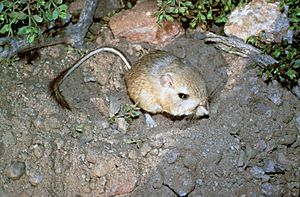Giant kangaroo rat facts for kids
Quick facts for kids Giant kangaroo rat |
|
|---|---|
 |
|
| Conservation status | |
| Scientific classification | |
| Genus: |
Dipodomys
|
| Species: |
ingens
|
The giant kangaroo rat (Dipodomys ingens) is a type of rodent that is in danger of disappearing forever. It lives only in California.
Contents
What is a Giant Kangaroo Rat?
The giant kangaroo rat is the biggest of more than 20 kinds of kangaroo rats. These small rodents are about 15 cm (5.9 in) long, including their long, tufted tail. They are tan or brown. Like other kangaroo rats, they have a large head and big eyes. They also have long, strong back legs that help them hop very fast.
Scientists have been studying giant kangaroo rats because their homes are shrinking. They found that these rats spend most of their time in their dens.
Where Do They Live?
Giant kangaroo rats live in dry, sandy grasslands. They dig burrows in loose soil. They live in groups, and they talk to each other by drumming their feet on the ground. These foot thumping signals can be short thumps or long "footrolls" with many quick drums. These sounds warn others about danger, mark their territory, and help them find mates.
Giant kangaroo rats mostly eat seeds. They also eat green plants and insects. Most giant kangaroo rats collect seeds when they can find them. They store these seeds in small holes on the ground or in their dens to eat later.
In spring and summer, these rats usually spend less than two hours outside their dens at night looking for food. They are very protective of their territory. They usually do not leave their den for more than 15 minutes a day.
Reproduction and Life Cycle
Giant kangaroo rats usually have 1 to 8 babies at a time, with about 3 on average. They live for only 2 to 4 years.
Mating for the giant kangaroo rat happens at certain times of the year. During the summer, male rats will leave their usual homes to find female rats nearby and mate. In the winter, the males stay in their own burrows. They also attract mates by sand-bathing. This is when the giant kangaroo rat rubs its sides in the sand, leaving a special scent.
Why Are They Endangered?
The giant kangaroo rat was declared an endangered species in the 1980s. This means they are at high risk of disappearing forever. They now live in less than 2% of the area they used to call home. You can only find them in a few separate places west of the San Joaquin Valley. These places include the Carrizo Plain, the Elkhorn Plain, and the Kettleman Hills.
Like many other rodents, the giant kangaroo rat lost much of its habitat. This happened when the Central Valley was turned into farmland. Scientists are still trying to learn more about these animals. They want to find the best ways to help them survive.
Protecting the giant kangaroo rat means keeping their homes safe. The biggest groups of these rats are in eastern Kern County, the Carrizo Plain National Monument, and the Panoche Region. Other important groups are in the Kettleman Hills, San Juan Creek Valley, and Cuyama Valley. These areas need to be protected and managed well for the rats to recover.
Because their habitats are now small and separated, the giant kangaroo rat populations are spread out. This makes it harder for them to find mates and stay healthy as a species. Scientists have found that moving some rats to new areas can help increase their numbers and genetic health.
- ARKive – images and movies of the Giant Kangaroo rat (Dipodomys ingens)


